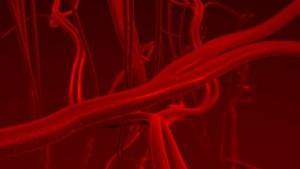Aneurysm
 An aneurysm is an abnormal bulge in the wall of an artery, an inflated balloon of blood. Aneurysms can occur in many parts of the body. They usually develop where pressure is strongest, that is, in areas where blood vessels divide and branch off. An aneurysm is extremely dangerous since it may result in rupture and subsequent hemorrhage or in the development of a serious clot, leading to a stroke or heart attack.
An aneurysm is an abnormal bulge in the wall of an artery, an inflated balloon of blood. Aneurysms can occur in many parts of the body. They usually develop where pressure is strongest, that is, in areas where blood vessels divide and branch off. An aneurysm is extremely dangerous since it may result in rupture and subsequent hemorrhage or in the development of a serious clot, leading to a stroke or heart attack.
Types of Aneurysm
Aneurysms can occur in many different parts of the body. They are usually categorized according to the types which occur most frequently:
- Aortic
- Cerebral
- Abdominal
- Thoracic
Peripheral aneurysms occur elsewhere in the body, possibly in the legs, neck, or groin.
Causes of an Aneurysm
There is no clearly recognized cause for the development of an aneurysm, but there are risk factors which make it more likely that a particular individual may develop one. These risk factors may include:
- Poor elasticity of arterial walls
- Plaque buildup on arterial walls
- High blood pressure
- High cholesterol
- Smoking
- Pregnancy
- Infections of the blood
Some aneurysms are present at birth. Others may result from a slight congenital defect in part of an arterial wall.
Symptoms of an Aneurysm
Aneurysms within the body or brain often cause no visible symptoms. If an aneurysm occurs near the body's surface, however, a throbbing mass may be visible. Symptoms of aneurysms may include:
- A pulsating lump
- Cramps of arms or legs during exercise
- Pain in arms or legs during rest
- Painful sores or ulcerations of the toes or fingers
- Radiating pain or numbness in the arm or leg
- Gangrene (tissue death)
The rupture of an aneurysm is life-threatening. Symptoms may include low blood pressure, rapid heart rate, and lightheadedness.
Diagnosis of an Aneurysm
Diagnosis of an aneurysm is done through a thorough physical examination and the use of diagnostic tests which may include: CT scan, MRI scan, ultrasound and angiography. If a ruptured aneurysm is suspected a cerebrospinal fluid analysis may be ordered.
Treatment of an Aneurysm
There are several ways to treat aneurysms depending on their location and severity. If an aneurysm is discovered in its early stages, the doctor can often keep it from rupturing with medication and regular checkups to see whether the aneurysm is enlarging. If surgery is necessary because the aneurysm has enlarged, is leaking or is believed to be in danger of rupturing, such surgery may be done in one of several ways. The doctor may make use of X-rays during the surgery to guide the stent to the proper location. The prognosis for successful surgery is usually excellent if the medical intervention is done in a timely fashion.
Surgery for an aneurysm involves replacing the weakened section of the affected blood vessel with an artificial tube, or graft. This procedure may be performed in one of two ways.
Open Surgery
During this repair procedure, the surgeon makes a large incision in the abdomen or chest in order to replace the damaged part of the artery.
Endovascular Aneurysm Repair (EVAR)
In this procedure, the surgeon uses a tiny tube, or stent, to prop open a blood vessel or to reinforce its wall. Since this procedure is minimally invasive, recovery time is shorter. Endovascular repair, however, is not appropriate for all patients and may require more follow-up maintenance than an open procedure.
Following surgery, patients are instructed to maintain a healthy body weight, eat foods low in fat content, stop smoking and engage in some form of aerobic exercise in order to reduce the risk of another aneurysm.
